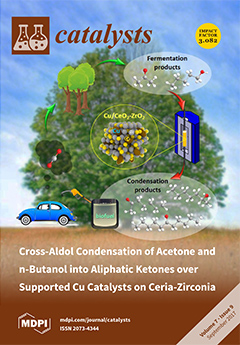Catalytic characteristics of hexahistidine-containing organophosphorus hydrolase (His
6-OPH) and its enzyme-polyelectrolyte complexes with poly-
l-glutamic acid or poly-
l-aspartic acid (His
6-OPH/PLD
50), hydrolyzing organophosphorous compounds, and
N-acyl homoserine lactones were studied in the presence of various
[...] Read more.
Catalytic characteristics of hexahistidine-containing organophosphorus hydrolase (His
6-OPH) and its enzyme-polyelectrolyte complexes with poly-
l-glutamic acid or poly-
l-aspartic acid (His
6-OPH/PLD
50), hydrolyzing organophosphorous compounds, and
N-acyl homoserine lactones were studied in the presence of various antibiotics (ampicillin, gentamicin, kanamycin, and rifampicin). The antibiotics at concentrations below 1 g·L
−1 had a negligible inhibiting effect on the His
6-OPH activity. Mixed inhibition of His
6-OPH was established for higher antibiotic concentrations, and rifampicin was the most potent inhibitor. Stabilization of the His
6-OPH activity was observed in the presence of antibiotics at a concentration of 0.2 g·L
−1 during exposure at 25–41 °C. Molecular docking of antibiotics to the surface of His
6-OPH dimer revealed the antibiotics binding both to the area near active centers of the enzyme subunits and to the region of contact between subunits of the dimer. Such interactions between antibiotics and His
6-OPH were verified with Fourier-transform infrared (FTIR) spectroscopy. Considering all the results of the study, the combination of His
6-OPH/PLD
50 with β-lactam antibiotic ampicillin was established as the optimal one in terms of exhibition and persistence of maximal lactonase activity of the enzyme.
Full article





